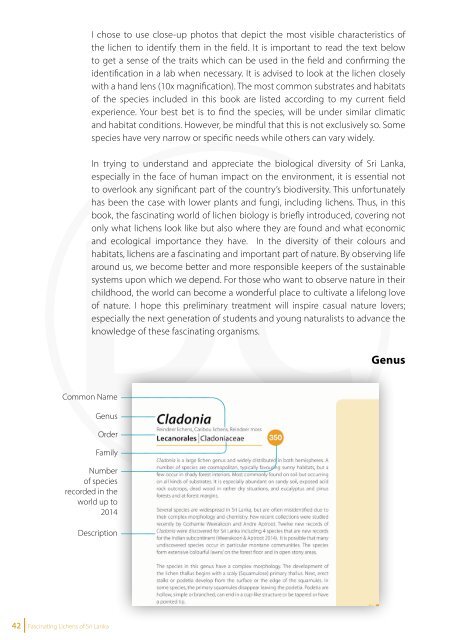You also want an ePaper? Increase the reach of your titles
YUMPU automatically turns print PDFs into web optimized ePapers that Google loves.
I chose to use close-up photos that depict the most visible characteristics <strong>of</strong><br />
the lichen to identify them in the field. It is important to read the text below<br />
to get a sense <strong>of</strong> the traits which can be used in the field and confirming the<br />
identification in a lab when necessary. It is advised to look at the lichen closely<br />
with a hand lens (10x magnification). The most common substrates and habitats<br />
<strong>of</strong> the species included in this book are listed according to my current field<br />
experience. Your best bet is to find the species, will be under similar climatic<br />
and habitat conditions. However, be mindful that this is not exclusively so. Some<br />
species have very narrow or specific needs while others can vary widely.<br />
Species<br />
In trying to understand and appreciate the biological diversity <strong>of</strong> <strong>Sri</strong> <strong>Lanka</strong>,<br />
especially in the face <strong>of</strong> human impact on the environment, it is essential not<br />
to overlook any significant part <strong>of</strong> the country’s biodiversity. This unfortunately<br />
has been the case with lower plants and fungi, including lichens. Thus, in this<br />
book, the fascinating world <strong>of</strong> lichen biology is briefly introduced, covering not<br />
only what lichens look like but also where they are found and what economic<br />
and ecological importance they have. In the diversity <strong>of</strong> their colours and<br />
habitats, lichens are a fascinating and important part <strong>of</strong> nature. By observing life<br />
around us, we become better and more responsible keepers <strong>of</strong> the sustainable<br />
systems upon which we depend. For those who want to observe nature in their<br />
childhood, the world can become a wonderful place to cultivate a lifelong love<br />
<strong>of</strong> nature. I hope this preliminary treatment will inspire casual nature lovers;<br />
especially the next generation <strong>of</strong> students and young naturalists to advance the<br />
knowledge <strong>of</strong> these fascinating organisms.<br />
Illustrations<br />
Common name<br />
Scientific name<br />
Description<br />
Status<br />
Habitat<br />
Locations<br />
Family<br />
name<br />
Family<br />
colour<br />
code<br />
Common Name<br />
Genus<br />
Order<br />
Family<br />
Number<br />
<strong>of</strong> species<br />
recorded in the<br />
world up to<br />
2014<br />
Description<br />
Genus<br />
Record Status<br />
E Endemic, SL new record for <strong>Sri</strong> <strong>Lanka</strong>,<br />
IC New record to Indian subcontinent<br />
and for <strong>Sri</strong> <strong>Lanka</strong><br />
E SL IC<br />
Distributation Status<br />
VC Very Common, C Common, R Rare,<br />
VR Very Rare, DD Data Deficient<br />
VC C R VR DD<br />
Cladoniaceae<br />
Coccocarpiaceae<br />
Coenogoniaceae<br />
Collemataceae<br />
Graphidaceae<br />
Pannariaceae<br />
Parmeliaceae<br />
Physciaceae<br />
Ramalinaceae<br />
Roccellaceae<br />
Colour<br />
Code<br />
<strong>Lichens</strong> Type<br />
Cr Crustose, Fr Fruticose, Fo Foliose<br />
Lecanoraceae<br />
Megalosporaceae<br />
Sphaerophoraceae<br />
Stereocaulaceae<br />
Cr Fr Fo<br />
Lobariaceae<br />
Usneaceae<br />
42 <strong>Fascinating</strong> <strong>Lichens</strong> <strong>of</strong> <strong>Sri</strong> <strong>Lanka</strong><br />
<strong>Fascinating</strong> <strong>Lichens</strong> <strong>of</strong> <strong>Sri</strong> <strong>Lanka</strong> 43















